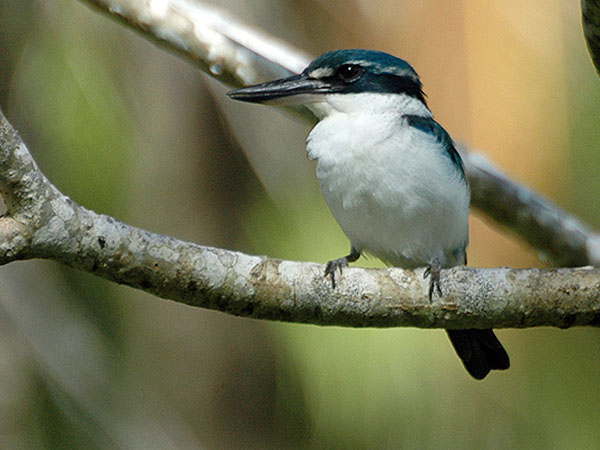The Collared Kingfisher (Todiramphus chloris (Boddaert)) has a extremely wide distribution and occurs from parts of Arabia well into western Polynesia; it is the only kingfisher living on the Fiji Islands (with three endemic subspecies) – yet, may there once have been another kingfisher species?

Photo: Tom Tarrant
http://creativecommons.org/licenses/by-sa/3.0
Rollo H. Beck, an American ornithologist, quotes some notes that he received by a Mr. G. T. Barker on June 5, 1925, during a stay on the island of Viti Levu, Fiji: ‘Notes by Mr. G. T. Barker, Suva, Fiji. June 5, 1925’.:
“Giant Kingfisher
I saw this bird, or a single bird at least, on two occasions and it rose, both times, from nearly the same place. On the last occasion, I was on the lookout for it and it passed within twenty feet in front of me so that I had a good opportunity to see it clearly. I was riding down from the village of Navuniwi, Viti Levu Bay, toward the beach and it was from a patch of swampy ground on my left that the bird arose.
The kingfisher was fully eleven inches long, with the same colored plumage as the small kind only more dingy. The blue was not so bright, and the white feathers on the wings were discolored. The back was nearly black. Its flight was heavy-much slower than that of the small species, and as it flew in a straight line toward the mangrove swamp on my right, I noticed that it held its head in a line with the shoulders.
Natives told me that these giant kingfishers were plentiful in the early days, but as the bird nested in the low mangrove, it has practically disappeared since the advent of the mongoose which is a vertitable beach comber, haunting the swamps and beaches. About twenty-five years previously I had seen one of them back of Ovalau, but was told that it was only stray in that part.
On the second occasion of my seeing the giant flycatcher [indeed, he writes flycatcher here instead of kingfisher], I dismounted from my horse and went into the swampy patch, finding that the bird had been eating the native sila (Job’s tears) [Coix lacryma-jobi (L.) Lam.].
Ordinary Flycatcher [?]
It is generally supposed that this bird is an insect eater, and does not eat fish, but this is not invariably so. As I was coming out of the Wainidoi River, ten miles below Suva, I saw a belo [Pacific Reef Heron (Egretta sacra (Gmelin))] fishing in shallow water, and getting close up, noticed that it had a kingfisher in company. Three times I saw the kingfisher dive into the shallow water after shrimps, then fly onto a rock to eat them.” [1]
So, what’s this somewhat strange account about?
There is indeed a possibility that the large Fijian Islands once harbored more than one kingfisher species, however, this particular account here pretty sure refers to the Collared Kingfisher, with the small species mentioned being the European Kingfisher (Alcedo atthis (L.)).
The whole account is expressed a bit unhappily, and this Mr. G. T. Barker very likely wasn’t a naturalist at all, that becomes very clear when he later also descibes a hummingbird that he had killed on the Fijian Island, and which in fact has been a honeyeater (Myzomela jugularis Peale) (his description, however, does not fully match that species, but that is another story ….).
*********************
References:
[1] Whitney South Sea Expedition of the American Museum of Natural History. Extracts from the journal of Rollo H. Beck. Vol. 2, Dec. 1923 – Aug. 1925
*********************
edited: 13.03.2020
